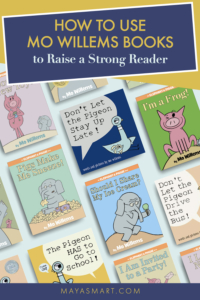By Karen Williams
Of all of the ways we can encourage learning and development in children, reading aloud to them is one of the simplest and most effective. Reading picture books to even the youngest children builds their vocabulary and comprehension. But what it doesn’t do, at least not automatically, is help them connect the lines on the page (which are so much less eye-catching than the illustrations) with the words they’re hearing.
To get the most out of story time, we need to draw kids’ attention to the letters and words on the page, in addition to the pictures—what’s known as “print referencing.” This easy tweak can make all the difference in helping listeners bridge towards readers. And few texts are better adapted for print referencing than Mo Willems’s popular picture books, with their comic-book style illustrations and speech bubbles.
You may even already be practicing print referencing without realizing it! Let’s delve in a little deeper to see how you can best leverage this super-easy but super-powerful tool for seeding reading.
What is Print Referencing?
Most simply, print referencing is pointing out text as you read aloud. Research has shown that, when presented with books, children are more likely to focus on the pictures on each page than the words. With print referencing, we draw their attention from the pictures to the words. This allows children to develop the awareness that we’re actually reading the text, not describing the pictures. This technique encourages several literacy skills as children get older, including language development, spelling, pronunciation, and pattern recognition.
The beauty of print referencing is that it is so easy to do, yet can have such an outsized impact on literacy. Here are some ways you can use print referencing during read-alouds with your children.
Trace or underline words as you read. No expensive kits or fancy accessories necessary! The key tool for print referencing is the simple yet effective index finger. By underlining words as you read to children, you focus their attention on the print itself, rather than just the pictures. Your kids will also learn about the pacing of a story, including when to pause or emphasize certain points. Older children may even notice that you pause at a period or exclaim at an exclamation point.
Identify any print in pictures. Although the focus here is the printed words making up the story, there may be pictures that contain words, too. For example, a book may have a sign that says STOP! These also offer great opportunities for print referencing. The key here is to identify the actual words used within the picture, as some children may be able to recognize the picture’s meaning without necessarily recognizing the words themselves.
Look for letters and sight words they recognize. As children develop literacy skills, they’ll begin to notice letters and words they’ve seen before. Encourage them to point out any they remember or recognize. You can also engage them with the text by asking questions like, “How many As do you see on this page?” or “Can you spot any letters you know?”
Print Referencing with Mo Willems’ Books
You can (and should) use print referencing with practically any picture book on your children’s shelves, but New York Times bestselling author-illustrator Mo Willems has written some of the best ones for pointing out words during read-aloud sessions. Willems borrows classic comic-book elements like speech bubbles and strips of illustrations with integrated text, and adapts them perfectly for the very youngest audiences. The simple, eye-catching pictures and easy-to-read print offer many opportunities to practice print referencing.
So what are you waiting for? Grab a Willems book—anything from the Elephant & Piggie series will serve perfectly, as will one of the popular Pigeon books—warm up your index finger, and get print referencing!
Resources for Parents:
The official Mo Willems website: Learn more about the author and his book collection, plus find suggested activities to go along with the stories.
7 Guaranteed Ways to Engage Kids with Family Read-Alouds
5 Reading-Aloud Tips to Get Your Child Kindergarten Ready



